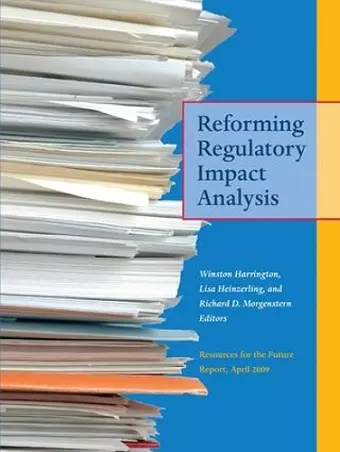Reforming Regulatory Impact Analysis
Winston Harrington editor Lisa Heinzerling editor Richard Morgenstern editor
Format:Hardback
Publisher:Taylor & Francis Ltd
Published:20th Apr '17
Currently unavailable, and unfortunately no date known when it will be back
This hardback is available in another edition too:
- Paperback£35.99(9781933115757)

Over the past decades, considerable debate has emerged surrounding the use of cost-benefit analysis (CBA) to analyze and make recommendations for environmental and safety regulations. Critics argue that CBA forces values on unquantifiable factors, that it does not adequately measure benefits across generations, and that it is not adaptable in situations of uncertainty. Proponents, on the other hand, believe that a well-done CBA provides useful, albeit imperfect, information to policymakers precisely because of the standard metrics that are applied across the analysis. Largely absent from the debate have been practical questions about how the use of CBA could be improved. Relying on the assumption that CBA will remain an important component in the regulatory process, this new work from Resources for the Future brings together experts representing both sides of the debate to analyze the use of CBA in three key case studies: the Clean Air Interstate Rule, the Clean Air Mercury Rule, and the Cooling Water Intake Structure Rule (Phase II). Each of the case studies is accompanied by critiques from both an opponent and a proponent of CBA and includes consideration of complementary analyses that could have been employed. The work's editors - two CBA supporters and one critic - conclude the report by offering concrete recommendations for improving the use of CBA, focusing on five areas: technical quality of the analyses, relevance to the agency decision-making process, transparency of the analyses, treatment of new scientific findings, and balance in both the analyses and associated processes, including the treatment of distributional consequences.
'Environmental regulations are an increasingly prominent issue for the federal government, and as such, the regulatory process recently has generated intense controversy. This book provides an in-depth analysis of three major environmental regulations, and constructively brings together key critics and advocates of current practices. Most importantly, the book provides concrete and timely recommendations for improving regulatory review.'
Ted Gayer, Georgetown University Public Policy Institute
'I applaud this project. The report brings together some of the staunchest advocates and critics of cost-benefit analysis and offers some very good, sensible recommendations on what should be done to improve the way that these analyses are conducted. That‘s an extremely important accomplishment for the policy community.'
Richard Revesz, New York University School of Law
'For those convinced that cost-benefit analysis will survive, in spite of cogent arguments against its utility in the environmental realm, this book is a must read. It provides detailed case studies of the use and abuse of Cost-Benefit Analysis and thoughtful recommendations for improving its use.'
David M. Driesen, Syracuse University College of Law
'This book acknowledges, but does not dwell on, the strengths and weaknesses of Cost-Benefit Analysis in regulatory development and review. Instead of continuing the ''tis to, 'tis not' debate, it looks for common ground and crafts productive proposals to improve the process. An important book for those who wish to continue the old debate and an essential one for those who can get beyond it.'
Sally Katzen, former administrator of the Office of Information and Regulatory Affairs, Office of Management and Budget (1993-1998)
ISBN: 9781138163850
Dimensions: unknown
Weight: 610g
242 pages